Which Social Media Channels See the Most ROI? [New Data + Expert Tips]
As any marketer knows, social media is an undeniably powerful tool to reach new audiences and connect with existing customers.
In fact, as of 2021, social media is now the #1 channel used by marketers.
But with all that Tweeting, Liking, Posting, and scrolling, it can be difficult to know which platforms give you the most bang for your buck.
Sure, it’s important to ensure your brand interacts on whichever platforms are most popular with your audience, but it’s equally critical you take the time to determine which platforms provide the best ROI for your business. This information can help you determine where to invest in paid advertising, as well as which channels you should use for lead generation.
However, social media usage can shift overnight. The platforms that provided marketers with the highest ROI five years ago likely don’t deliver the same results anymore. That’s why we conducted research to find out where marketers saw the highest ROI in 2021.
Here, we’ll explore which channels provided marketers with the highest ROI in 2021. We also reached out to experts at Talkwalker, Socialinsider, Casted, Brandfolder, LiveChat, Sprout Social, MarketingLabs, and HubSpot to determine how marketers can leverage certain tactics within those channels to increase engagement and drive sales. Let’s dive in.
Which social media channels have the best ROI?
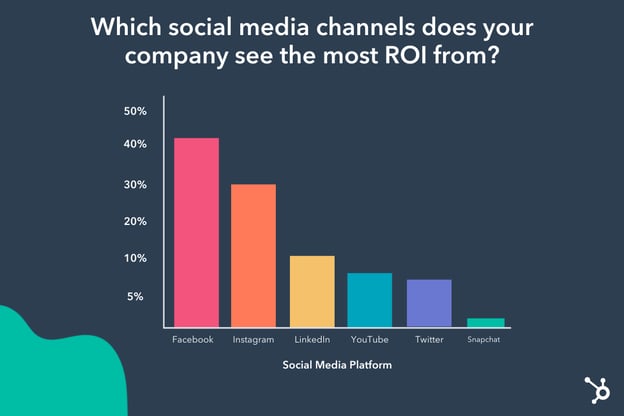
According to HubSpot’s 2021 State of Marketing report, Facebook is the social media channel that provides marketers with the highest ROI.
Over 40% of marketers cited Facebook as the most effective channel for their businesses, followed by the roughly 30% who saw the highest ROI from Instagram, which is another Facebook-owned social platform.
By comparison, the other social channels in the list — including LinkedIn, YouTube, Twitter, and Snapchat — all ranked much lower, with less than 10% citing each platform as the best channel for ROI.
Let’s dive into each of these platforms to uncover why the top 3 social media sites perform better than others when it comes to ROI — and how you can leverage them.
1. Facebook
With roughly 2.8 billion monthly active users as of 2021, Facebook has an undeniably impressive reach. It also offers advertising opportunities to more than 200 million businesses, making it one of the most popular advertising platforms.
With Facebook, marketers can advertise on a user’s News Feed, via Messenger or video, and more. Marketers can also leverage Facebook Lead Ads to encourage Facebook users to fill out a lead generation form without leaving the social platform.
One of the major benefits of Facebook’s advertising tools is its segmentation abilities. You can target your ads towards certain audiences depending on interests, demographics, behaviors, or even connection to your business — like whether they’ve attended one of your events, or have friends who’ve liked your Business Page. These targeting capabilities can help your business reach users who are most likely to purchase your product or service.
Nicole Ondracek, HubSpot’s Paid Advertising Marketing Manager, agrees that Facebook is an incredibly viable channel. She told me, “At HubSpot, Facebook is a valuable channel for us in driving return on ad spend. A main reason why is that we can provide our content to a relevant audience using Facebook’s audience targeting features. For instance, Facebook’s lookalike audiences allow us to go after people who look like our current customers.”
“Facebook’s algorithm is great at finding similar audiences who are likely to convert, which is why we see a positive return on investment going after these types of audiences.”
Take a look at HubSpot’s How to Run Facebook Ads: A Step-by-Step Guide to Advertising on Facebook to learn how to set up your own Facebook ads.
2. Instagram
With over one billion Instagram users, it’s unsurprising that Instagram is second in this list when it comes to ROI. Instagram offers marketers the ability to increase reach, engagement, and sales through a variety of methods, including Instagram Shoppable ads, Stories, branded content, Reels, and more.
The platform has proven a viable strategy for businesses. In fact, 90% of users follow a business on Instagram, and 50% of users are more interested in a brand after seeing ads for it on Instagram.
So … why doesn’t it surpass Facebook for generating ROI?
Most likely, Instagram falls short of producing strong ROI due to its more intangible metrics — such as brand awareness, reputation, loyalty, and consumer engagement.
For instance, an Instagram user might never click on one of your business’ ads directly from the platform. Instead, perhaps the ad simply increases a user’s awareness of your brand. Down the road, perhaps they click on your website after seeing a Google ad. Certain metrics are difficult to attribute to Instagram, but that doesn’t mean it isn’t a good idea for your business.
3. LinkedIn
Despite only roughly 10% of marketers rating LinkedIn as their top channel for ROI, LinkedIn is an incredibly effective channel for lead generation and nurturing. Over 750 million professionals use LinkedIn for networking, career advancement, and more.
The platform offers a variety of tools designed to increase your business’ ROI, including Sponsored Content, Sponsored Messaging, Text or Video ads, and more.
To succeed on the platform, you’ll want to create valuable content that resonates with your LinkedIn audience. Conduct research to determine which types of content perform best on LinkedIn — and which content will perform best with your target audience — to ensure you’re hitting the mark here.
Additionally, try running experiments when you start using LinkedIn’s advertising tools. For instance, Cellular IoT Connectivity company Aeris set up an ad plan and tracker to determine which targeting combinations worked best for the brand, which failed, and which generated the highest-quality leads. As noted in this post, “It took rounds of testing and optimization to get to [the brand’s] 25% submission rates.”
Now that we’ve explored a few of 2021’s most popular social channels, let’s explore the strategies and best practices you can implement to increase your ROI across platforms, according to experts.
Which social media tactics or strategies have the best ROI?
1. Conducting extensive research to understand your audience.
First and foremost, it’s vital you understand your audience before creating any social media campaign. If you don’t do your research, you risk spending time, money, and resources on the wrong channels — and missing out on more profitable connections elsewhere.
As Dan Seavers, Content Marketing Manager at Talkwalker, told me, “No matter the social media channel, the best way to increase your ROI is by improving your consumer intelligence. Get to know your customers better than your family, and understand what they’re saying about your products, and where they’re discussing them.”
“That way, when you launch a campaign, you’ll be hyper-relevant. Not a jarring ad that interrupts a customer’s life, but a well-timed, well-targeted experience that people will engage with instantly.”

2. Creating more video content — and testing out vertical videos.
People love videos – and yet, it seems most brands rely on images when advertising their products or services, and that’s a mistake.
Adina Jipa, co-founder of Socialinsider, told me, “The most underused social media post is video content, which boosts engagement across all social media platforms.”
“Facebook wants to become a video-first platform and favors pages with video content, but for most brands, it is [primarily] a photo-sharing platform.”
Jipa adds, “A recent study about Facebook video strategy shows that only roughly 15% of the content [on Facebook] is video, while photos represent 38.58%.”
To stand out and increase ROI, consider how you might incorporate video into your social media efforts.
Additionally, consider testing out different types of video formats across your channels. For instance, Facebook offers brands the opportunity to create vertical video ads for the mobile-friendly user.
As Jipa points out, “you can use vertical videos on ads to get more clicks. According to this poll, almost 69% of marketers say video ads outperform image and plain text ads on Facebook. 81% of Facebook users only access the platform via mobile devices, so using the vertical video format allows you to get more visibility and increase the chances of getting more clicks. Facebook videos ads can increase the CTR by 2-3X.”
3. Re-using content across channels.
Most social teams create content in silos. Perhaps they tell one message via an Instagram post, and then create entirely different materials for a YouTube video or Tweet.
This undoubtedly requires a lot of time, effort, and resources — which can become frustrating when you don’t see the ROI you need from these channels.
“Far too often, content is created for one-and-done campaigns or promotions,” Casted’s CEO and Co-founder Lindsay Tjepkema says. “This means marketers are working harder and harder to constantly produce more and more, yet ROI and ROE (return on effort) results are disappointing — and social is no exception.”
She continues, “To change this, we must stop creating content for content’s sake and start focusing instead on creating content that educates, entertains, and delights and can be broken down and amplified across all other channels — like social — not just once, but many times over. When you focus on creating engaging content that can be used in multiple ways across channels, you’ll see improved ROI and ROE (return on effort) across your campaigns — including your social activation.”
To repurpose your content across channels, perhaps you post snippets of a full YouTube video on Facebook or Instagram. Alternatively, maybe you take text from a blog post and re-post on your channels to add value from your existing content, repurpose user-generated content across channels.
There are countless ways to refresh and re-use content to appeal to new audiences in unique ways without exhausting your social team.
4. Setting clear goals and devising a social strategy that works for your brand.
It’s difficult to achieve results on social without taking the time to set clear goals for your team, and ensuring you’ve all discussed an appropriate strategy to get you there.
As Brandfolder’s Senior Digital Marketing Manager Amanda Turcotte told me, “In order to achieve a return on your social media investment, you must have clear goals set before any tactical planning takes place. Various social media tactics can be applied differently to each of the platforms, meaning they’ll produce different outcomes. So your goals need to be determined up front to ensure they’re aligned with your social strategy.”
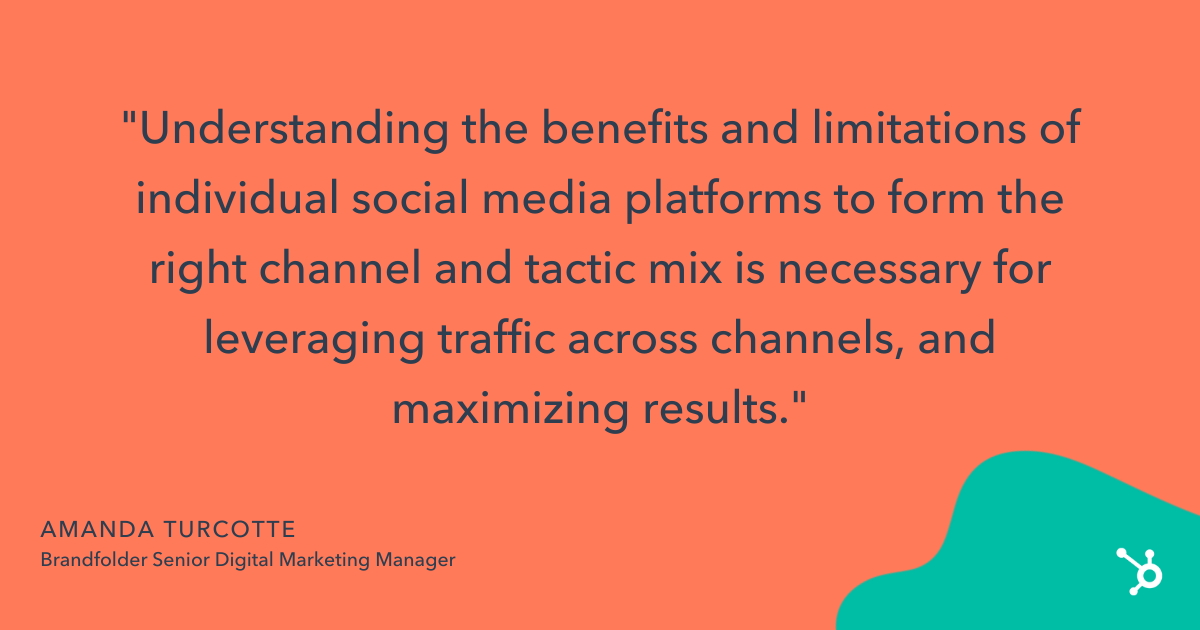
Once you’ve determined your social goals, you’ll want to create a consistent posting strategy so your audience knows when, and how often, they can expect content from your brand. To make this easier, try using a social posting tool like HubSpot’s Social Inbox Tool or Later.
Turcotte told me, “In order to move your team from strategy to action and keep everyone on the same page, it’s crucial to develop a regular posting plan that documents your approach across each channel, located where all team members have access. ”
Agnieszka Jaśkiewicz, Head of Social Media & Community at LiveChat, agrees that creating a strategy and using tools to support your team’s goals is critical for finding success on social channels.
As she puts it, “The greatest area of ‘untapped potential’ for most brands comes in the form of streamlining creative workflows to support the volume needed for quality social activity. Digital workspaces that allow creatives and marketers to collaborate from a central location to stage, revise, and produce content limits back-and-forth communication and unnecessary steps in production.”
Additionally, Jaśkiewicz says, “Digital templates for creative assets — set to the specifications of the organization’s core social media platforms — can also add agility to social media managers’ ability to publish, allowing teams to be more timely and quickly act on new opportunities.”
5. Allow your users to purchase your products or services on social media platforms.
Over the past few years we’ve seen rise to a new trend: social commerce.
In essence, social commerce is the ability to purchase from a brand within a social platform without leaving the site. Examples include shoppable ads and chatbot checkout.
Rachael Samuels, Senior Manager of Social Media at Sprout Social, told me she sees social commerce as a great opportunity to increase ROI on social channels.
Samuels says, “Social media has quickly become a primary communication channel for brands and consumers alike. As a result, marketers must seek new ways to engage with audiences while keeping other goals, such as lead generation, top of mind.”
“One way we’re seeing this unfold is through offerings like social commerce, which not only provide more seamless buying experiences for customers, but equip marketers with the ability to show direct attribution and ROI as a result of their efforts.”
Samuels adds, “To maintain this momentum, marketers should ensure their tech stack enables them to integrate their CRM and social management tools so they can easily surface social insights with their broader sales and support teams."
6. Use UTM tags for tracking.
One reason you might not be seeing the ROI you’re hoping for? Perhaps you’re just not tracking properly.
As Matt Janaway, CEO of MarketingLabs, told me: "Tracking is now more important than ever thanks to the complications of iOS privacy improvements, so to really yield the best ROI, you have to make sure you are using UTM tags on all links. This way, you can correctly track the performance of your campaigns in Analytics.”
Janaway adds, “This should give you the data you need to make decisions that can drive more engagement and ROI.”
7. Encouraging your employees to become brand ambassadors.
One area of major untapped potential? Your employees.
As Casted’s Tjepkema tells me, “Employee activation is a huge and mostly untapped resource for brands. As consumers, we’re far more driven to engage with user-generated content, yet so many brands spend too much time and money trying to only push content from their own brand instead of enabling their employees (and partners, brand fans, etc.) to amplify their content.”
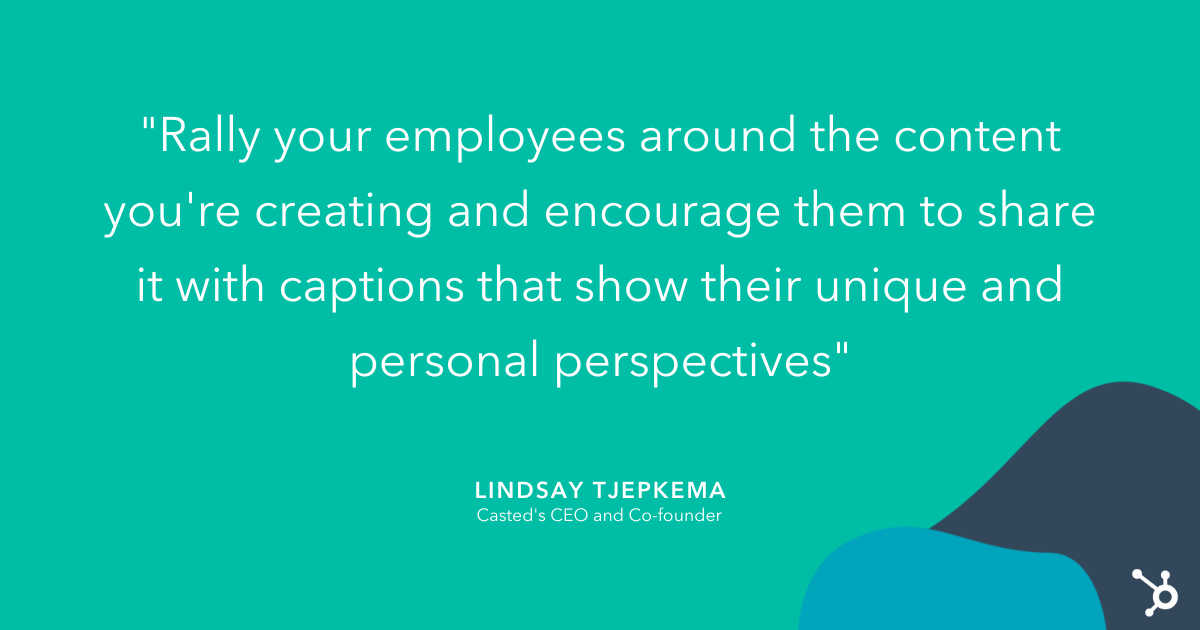
LiveChat’s Jaśkiewicz agrees with this notion, saying, “[You should] give employee advocacy a bigger seat at the table in your social media strategy, especially when it comes to LinkedIn. It takes some time and effort to provide people with the knowledge and imply the 'brand ambassadors’ mindset in the organization — however, employee engagement is a cost-effective way to increase your reach organically.”
HubSpot, for instance, created #HubSpotEmployeeTakeover on its HubSpot Life Instagram account. The campaign helps show audiences the faces behind the brand, and creates a sense of community and authenticity that you wouldn’t find with branded content alone.
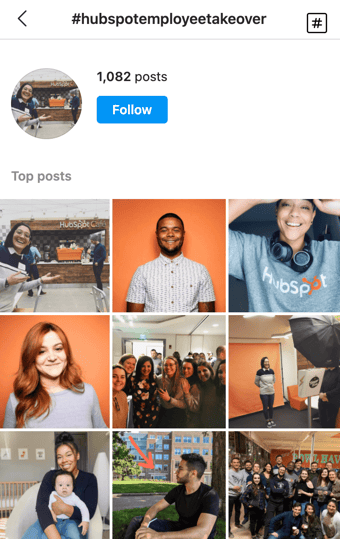
Increasing ROI across your social channels won’t happen overnight — but by applying these strategies and remaining dedicated to iterating on your strategy as you collect audience insights over time, you’ll surely begin to see stronger results from your social efforts.
Happy posting!
source https://blog.hubspot.com/marketing/social-media-channel-roi
from RANK And EXPAND YOUR BUSINESS WITH US https://socialmediamarketingconsultantseo.blogspot.com/2021/08/which-social-media-channels-see-most.html
source https://socialmediamarketingexpert.tumblr.com/post/661031648940507136

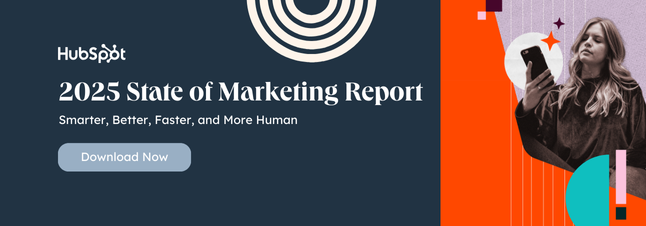
Comments
Post a Comment